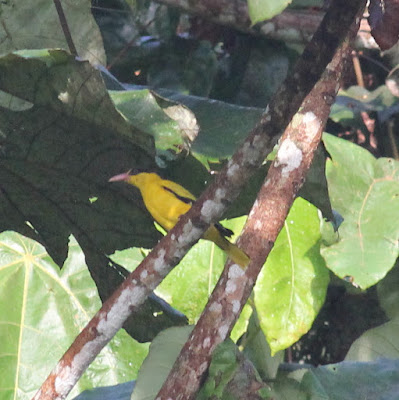At Ulu Dedap ricefields, the Eastern Marsh Harriers (EMH) were plenty and very much closer. For two continuous days (7-8 January 2012), we were up as early as 5.00am and was on the road by 6.00am in order to reach the ricefields by 6.30am.
Here are some interesting info and facts obtained from the site:
i) There were on average about 130 EMHs seen at this place alone. The highest count observed was 145 while the lowest was 108.
ii) The earliest EMH to leave the roost was recorded at 0700hrs and the last to return was at 1950hrs.
iii) 90% of the raptors observed at Ulu Dedap ricefields were EMHs and about 8% were Pied Harriers with the remaining 2% consisted of other raptors eg Peregrine Falcon, Brahminy, Black Kite and Black Shouldered Kite.
iv) There were more males (EMHs) than females (EMHs) and a few juveniles.
v) There were more female Pied Harriers than male Pied Harriers as well as a few juveniles.
vi) Most of the Harriers would leave their roosting site at Ulu Dedap at dawn and returned at dusk. Only one or two would remained in Ulu Dedap to search for food.
vii) There were not a single Eastern Imperial Eagles nor Greater Spotted Eagles seen during our 2 days at Ulu Dedap ricefields.
There are several quick and simple ways to id EMHs and Pied Harriers which i have learnt from the experts. I will try to id some of them here:
Features: not so white body, streaked near chest area and whithish thighs = female Pied Harrier ?
Expert's comment (Yang Chong): "Your educated guess of the 1st pic is correct, a Pied Harrier female with clearly shown diagnostic white thighs, broad trailing edge on underwings and barrings on primary wing bases and flight feathers"
Note: Other features which you could look for on Pied Harriers are: pale face and smaller heads as compared to EMHs (info adopted from Rafi Kudus - "Identifying Harriers" talk at MNS on 31 Jan 2013)
Features: brown body, rufous thighs, and with breast band = 3rd year female EMH?
Expert's comment (Yang Chong): "
2nd pic definitely Eastern Marsh juv., primary bases unmarked but this is not I think a very young bird because of somewhat worn feathers, also moult in tail"
Features: head brown, body brown, with supercilium, white patch on the nape and no streaked on throat = juvenile Pied Harrier?
Expert's comment (Yang Chong): "
The 3rd pic appears to be an Easterm Marsh Harrier juv. showing all brown underparts, alas the unmarked primary bases cannot be seen in the pic. Pied Harrier juv. would show pale areas above eyes and on ear-coverts and barred primary bases"
Features: white body, lesser brown streaks near chest area and brown upper parts = 3rd Year EMH
Features: white body, lesser streaked neck and breast = Male Eastern Marsh Harrier
Expert's coment (Yang Chong): "
Your photo actually shows a juv male Eastern Marsh Harrier"!
Note: Other feature which to id a male EMHs is to see its scales like feathers on top of its wings. (info adopted from Rafi Kudus - "Identifying Harriers" talk at MNS on 31 Jan 2013).
My score: 2 correct, 1 half correct & 1 wrong - boleh tahan lah !
Features: underparts like a disease bird, rufous thigh, head light brown and with a rat on its talons = female Pied Harrier ?)
Note: oh dear all this while i thought this bird is a Pied Harrier but it is actually a Juv EMH - according to Rafi Kudus it has blotchy marks, no barrings on its primaries although a juv EMH also has whithish facial colors.
(FOR ADDITIONAL INFO - KINDLY READ DAVE BAKEWELL'S INPUT IN THE REPLY SECTION BELOW)
An EMH taking off at first light. On top of the gravel mount was a Peregrine Falcon (japonensis sp).
The remains of a Cinnamon Bittern after the Peregrine Falcon flew off.
At times EMH would approach and search its prey at low level.
Then they would rise above again.
...and kept scanning below.
Then the EMH will turn around once they have spotted something on the ground.
Then the EMH would dive bomb the prey like this one.











































































